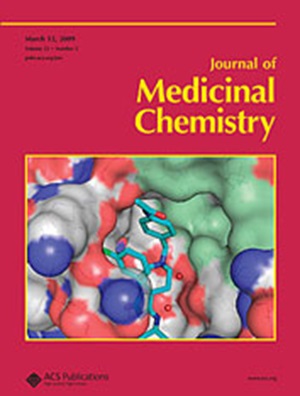Design of a Tetravalent RGD Peptide Capable of Simultaneous Binding with Multiple Integrin αvβ3 for Targeted Radionuclide Therapy
IF 6.8
1区 医学
Q1 CHEMISTRY, MEDICINAL
引用次数: 0
Abstract
For targeted radionuclide therapy, radioligands that exhibit high and persistent tumor uptake are indispensable. We previously synthesized a 99mTc-labeled hexavalent RGD peptide (99mTc-(RGD)6) as a tumor imaging agent targeting integrin αvβ3. 99mTc-(RGD)6 showed high in vivo tumor uptake with long retention due to simultaneous binding to multiple integrin αvβ3 receptors. The purpose of this study was to apply this finding to the design of a multivalent RGD peptide labeled with 211At, a promising α-emitting radionuclide for radionuclide therapy. As a candidate compound, a tetravalent RGD peptide (H2N-(RGD)4) was synthesized and radiolabeled with 125I, a homologous element of At, for basic studies. As expected, 125I-(RGD)4 retained the capability of simultaneous binding and showed comparable in vivo tumor uptake to 99mTc-(RGD)6. Finally, 211At-(RGD)4 was synthesized with >95% radiochemical purity and exhibited an almost identical biodistribution pattern to 125I-(RGD)4. These results indicate that 211At-(RGD)4 might be a potential radioligand for integrin αvβ3-targeted radionuclide therapy.

求助全文
约1分钟内获得全文
求助全文
来源期刊

Journal of Medicinal Chemistry
医学-医药化学
CiteScore
4.00
自引率
11.00%
发文量
804
审稿时长
1.9 months
期刊介绍:
The Journal of Medicinal Chemistry is a prestigious biweekly peer-reviewed publication that focuses on the multifaceted field of medicinal chemistry. Since its inception in 1959 as the Journal of Medicinal and Pharmaceutical Chemistry, it has evolved to become a cornerstone in the dissemination of research findings related to the design, synthesis, and development of therapeutic agents.
The Journal of Medicinal Chemistry is recognized for its significant impact in the scientific community, as evidenced by its 2022 impact factor of 7.3. This metric reflects the journal's influence and the importance of its content in shaping the future of drug discovery and development. The journal serves as a vital resource for chemists, pharmacologists, and other researchers interested in the molecular mechanisms of drug action and the optimization of therapeutic compounds.
 求助内容:
求助内容: 应助结果提醒方式:
应助结果提醒方式:


